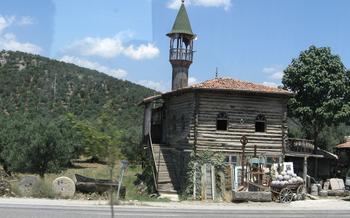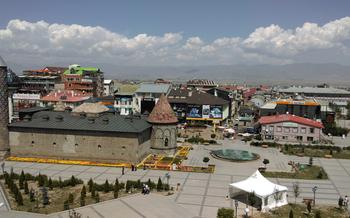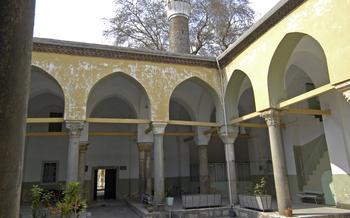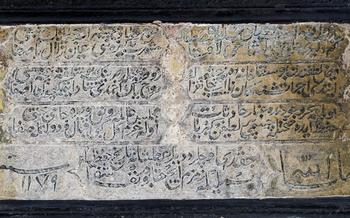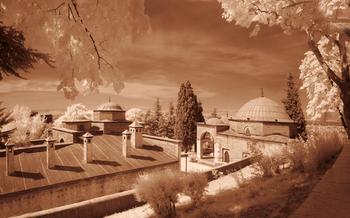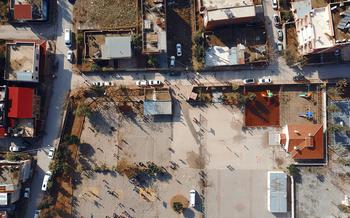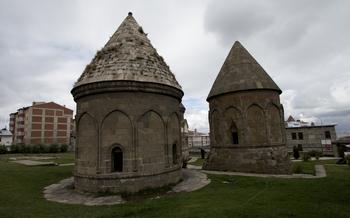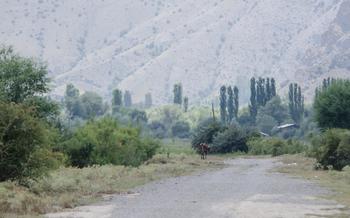
Ulu Cami (Grand Mosque)
- The Ulu Cami in Erzurum: A Historical Masterpiece
- Location and Transportation
- Exploring the Mosque's Interior
- Learning about the Mosque's History and Architecture
- Participating in Religious Ceremonies
- Exploring the Neighborhood Around the Mosque
- The Ulu Cami's Role in the Community
- The Ulu Cami and Erzurum's Winter Festival
- Tips for a Memorable Visit
- The Ulu Cami in Literature and Art
- Erzurum's Unique Winter Landscape
- Tips for staying warm and enjoying the winter weather
- Combining the Ulu Cami with Other Erzurum Attractions
- Insider Tip: Discovering Hidden Gems
The Ulu Cami in Erzurum: A Historical Masterpiece
The Ulu Cami, also known as the Grand Mosque, stands as a testament to Erzurum's rich history and architectural prowess. Constructed in the 12th century during the Seljuk era, this magnificent edifice has undergone several renovations and expansions over the centuries, reflecting the city's changing rulers and architectural styles. The mosque's captivating blend of Seljuk, Ottoman, and Armenian influences makes it a true masterpiece, showcasing the diverse cultural heritage of Erzurum.
Beyond its architectural significance, the Ulu Cami holds deep cultural and religious importance for the people of Erzurum. As one of the oldest and largest mosques in the city, it serves as a central place of worship and a gathering place for the Muslim community. The mosque's intricate tilework, grand dome, and serene atmosphere create a spiritual sanctuary that invites contemplation and reflection.
Location and Transportation
The Ulu Cami stands tall in the heart of Erzurum, on Kazım Karabekir Caddesi, a bustling street lined with shops and historical buildings. Reaching the mosque is a breeze, whether you choose public transportation or prefer the convenience of a taxi. Multiple bus lines stop nearby, making it easy to get there from different parts of the city. For those arriving by car, limited parking is available in the vicinity. The mosque's accessible design ensures that visitors with disabilities can easily enter and navigate the premises.
Exploring the Mosque's Interior
Stepping into the Ulu Cami's vast interior is like embarking on a journey through time and art. Prepare to be captivated by the intricate tilework that adorns every corner of the mosque, showcasing mesmerizing geometric patterns and vibrant hues. Verses from the Quran, written in elegant calligraphy, grace the walls, adding a spiritual dimension to the space.
Raise your gaze to admire the grand dome, a masterpiece of architectural ingenuity. Its intricate designs and patterns converge at a central point, creating a sense of awe and wonder. The massive chandelier suspended beneath the dome adds a touch of grandeur, casting a warm glow over the entire space.
As you wander through the prayer hall, notice the mihrab, an exquisitely decorated niche that indicates the direction of Mecca. Its intricate carvings and vibrant colors draw the eye, creating a focal point for worshipers.
Don't miss the opportunity to discover the mosque's unique features, such as the marble pulpit, adorned with delicate carvings, or the stained glass windows that filter sunlight, casting colorful patterns on the floor. Each element of the Ulu Cami's interior tells a story, inviting visitors to delve deeper into its rich history and cultural significance.
Learning about the Mosque's History and Architecture
Enhancing your visit to the Ulu Cami involves delving into its rich history and remarkable architecture. While exploring the mosque, take advantage of the informative panels or brochures that provide detailed insights into its construction, design, and significance. Guided tours led by knowledgeable historians or architects offer an even deeper understanding of the mosque's unique features and the stories behind them.
To further your exploration, consider delving into recommended books or websites that delve into the mosque's history, architectural style, and cultural impact. These resources often provide fascinating historical anecdotes and legends associated with the mosque, adding another layer of intrigue to your visit.
Participating in Religious Ceremonies
As a non-Muslim visitor, it's important to be mindful of the etiquette and dress code when entering the Ulu Cami. While you are welcome to observe religious ceremonies and festivals, it's crucial to respect the sanctity of the mosque during prayer times. Visitors should dress modestly, avoiding revealing or tight clothing. Women may be required to cover their hair with a headscarf or shawl as a sign of respect.
During your visit, you might have the opportunity to witness religious ceremonies such as the daily prayers or the weekly Friday sermon. These ceremonies offer a glimpse into the spiritual life of the Muslim community. While you are not expected to participate, it's a valuable experience to observe and learn about the rituals and traditions of Islam.
If you're fortunate, you might also encounter special religious festivals or events taking place at the mosque. These festivals often involve colorful processions, traditional music, and communal feasts. Participating in these events provides a unique opportunity to immerse yourself in the vibrant religious culture of Erzurum.
Remember, the Ulu Cami is first and foremost a place of worship for the Muslim community. While visitors are welcome, it's essential to be respectful of the religious practices and traditions observed within the mosque.
Exploring the Neighborhood Around the Mosque
Beyond its religious significance, the Ulu Cami is also a hub of activity and a gateway to exploring Erzurum's vibrant neighborhood. Take a stroll through the narrow streets surrounding the mosque and discover a treasure trove of local markets, shops, and restaurants. Browse for traditional Turkish handicrafts, carpets, and souvenirs, or indulge in delectable local cuisine at one of the many eateries nearby.
Within walking distance of the mosque, you'll find several other historical landmarks worth visiting. The Yakutiye Medresesi, a 14th-century theological school, is a testament to Erzurum's rich educational heritage. The Erzurum Kalesi, an imposing fortress, offers stunning panoramic views of the city and the surrounding mountains.
Don't miss the opportunity to sample Erzurum's famous cağ kebabı, a unique skewer-grilled meat dish that is a local specialty. You can find it at many restaurants near the Ulu Cami, often served with freshly baked bread and grilled tomatoes.
As you explore the neighborhood, don't hesitate to interact with the friendly locals. They are proud of their city and its rich history, and they are always happy to share stories and recommendations with visitors. Ask them about their favorite spots for food, shopping, or sightseeing, and you might just uncover some hidden gems that only locals know about.
The Ulu Cami's Role in the Community
Beyond its religious significance, the Ulu Cami plays a vital role in the community of Erzurum. It serves as a place of worship, gathering, and education, fostering a sense of unity and belonging among the locals. The mosque hosts various social and educational activities, including religious classes, lectures, and workshops. It also organizes community outreach programs, such as charity drives, food distributions, and healthcare initiatives, demonstrating its commitment to serving the needs of the people. Moreover, the Ulu Cami actively participates in preserving local traditions and culture, hosting cultural events, exhibitions, and festivals that celebrate Erzurum's rich heritage.
The Ulu Cami and Erzurum's Winter Festival
The Ulu Cami takes center stage during Erzurum's annual Winter Festival, a vibrant celebration of the city's cultural heritage and winter traditions. The mosque serves as a stunning backdrop for the festival's festivities, which include traditional music and dance performances, art exhibitions, and culinary delights.
During the festival, the Ulu Cami's courtyard and surrounding area transform into a winter wonderland, adorned with twinkling lights, festive decorations, and ice sculptures. Visitors can enjoy ice skating, snow sledding, and other winter activities, while indulging in delicious local cuisine and beverages.
The Ulu Cami's role in the festival extends beyond its physical presence. The mosque's history, architecture, and cultural significance are highlighted through guided tours, lectures, and workshops, providing visitors with a deeper understanding of Erzurum's rich heritage.
To fully immerse yourself in the festival's atmosphere, consider attending the opening ceremony, which takes place at the Ulu Cami. This grand event features a colorful procession, traditional rituals, and speeches by local dignitaries, showcasing the city's pride and cultural diversity.
Whether you're a history buff, a winter enthusiast, or simply seeking a unique cultural experience, the Ulu Cami and Erzurum's Winter Festival are a must-visit. Embrace the magic of the season as you explore this architectural masterpiece amidst a vibrant celebration of Erzurum's spirit.
Tips for a Memorable Visit
To make the most of your visit to the Ulu Cami, consider the following tips:
-
Timing is Everything: Visit during the golden hours of sunrise or sunset to capture the mosque's stunning exterior bathed in warm light.
-
Dress Respectfully: The mosque is a place of worship, so dress modestly. For women, a headscarf or shawl is recommended as a sign of respect.
-
Silence is Golden: Remember that the Ulu Cami is an active mosque. Be mindful of your voice level and maintain a respectful silence, especially during prayer times.
-
Capture the Beauty: Photography is allowed inside the mosque, but be respectful and avoid using flash or tripods. Capture the intricate details of the tilework, calligraphy, and architecture.
-
Engage with the Locals: Strike up conversations with locals visiting the mosque. Ask questions, listen to their stories, and gain insights into the mosque's significance in their lives.
The Ulu Cami in Literature and Art
The Ulu Cami has served as an enduring source of inspiration for Turkish artists and writers. In the realm of literature, renowned Turkish poets such as Yunus Emre and Karacaoğlan have penned verses that evoke the mosque's grandeur and spiritual significance. These poetic tributes, passed down through generations, celebrate the Ulu Cami as a symbol of Erzurum's rich cultural heritage.
In the visual arts, the mosque's distinctive architecture and captivating beauty have been immortalized in paintings, drawings, and photographs. Renowned Turkish artists like Şeker Ahmet Paşa and Osman Hamdi Bey have captured the mosque's essence through their masterful brushstrokes, showcasing its intricate details and harmonious proportions. These artworks not only serve as a testament to the mosque's architectural marvel but also contribute to its enduring legacy as a symbol of Erzurum's cultural identity.
Personally, I stumbled upon a hidden gem during my visit to the Ulu Cami. While exploring the mosque's courtyard, I noticed a small, unassuming door tucked away in a corner. Curiosity piqued, I cautiously opened the door and discovered a secluded chamber. Inside, I found a collection of ancient manuscripts, each containing handwritten verses from the Quran. The sight of these sacred texts, carefully preserved within the mosque's walls, filled me with a sense of awe and reverence. This unexpected discovery reminded me of the Ulu Cami's profound significance as a center of Islamic learning and devotion.
Erzurum's Unique Winter Landscape
Erzurum is renowned for its frigid winters and picturesque snowy landscapes. The city's unique climate transforms the Ulu Cami into a breathtaking sight, as the mosque's domes and minarets glisten under a blanket of pristine snow. The surrounding cityscape, adorned with snow-capped mountains and snow-covered streets, creates a magical winter wonderland.
Winter in Erzurum offers a range of activities and attractions for visitors. Skiing enthusiasts can indulge in thrilling adventures at the nearby Palandöken Ski Center, boasting world-class slopes and facilities. The city also hosts the annual Erzurum Winter Festival, a vibrant celebration showcasing local culture, sports competitions, and exciting events.
Despite the cold weather, embracing the winter charm of Erzurum is an unforgettable experience. Visitors can enjoy cozy evenings by the fireplace in traditional cafes, savor delicious local cuisine, and immerse themselves in the city's vibrant winter atmosphere.
Tips for staying warm and enjoying the winter weather
- Dress in layers: Wear warm, moisture-wicking clothing to stay comfortable in the cold.
- Invest in good footwear: Choose sturdy, waterproof boots with good traction to navigate snowy and icy conditions.
- Stay hydrated: Drink plenty of water to prevent dehydration, as the cold weather can be deceiving.
- Take breaks indoors: If you start to feel too cold, warm up in a cozy cafe or museum before venturing back outside.
- Embrace the local cuisine: Indulge in hearty Turkish dishes such as keşkek, a traditional winter stew, to stay energized and warm.
Combining the Ulu Cami with Other Erzurum Attractions
To make the most of your trip to Erzurum, consider combining your visit to the Ulu Cami with other attractions in the city. Erzurum is home to a wealth of historical, cultural, and natural wonders that offer a diverse range of experiences.
Just a short walk from the Ulu Cami, you can explore the Erzurum Archaeology Museum, which houses a fascinating collection of artifacts from the region's rich past. The museum's exhibits include ancient pottery, jewelry, sculptures, and inscriptions that shed light on the diverse civilizations that have flourished in Erzurum throughout history.
For a taste of Erzurum's modern culture, head to the Cumhuriyet Caddesi, the city's main shopping street. Here, you can browse local shops, enjoy traditional Turkish cuisine at one of the many restaurants, or simply soak up the lively atmosphere.
If you're interested in exploring the natural beauty of the region, consider taking a day trip to the Tortum Waterfall, located about an hour's drive from Erzurum. This stunning waterfall is surrounded by lush forests and offers breathtaking views. You can also visit the nearby Palandöken Mountains, which offer world-class skiing and snowboarding opportunities during the winter months.
By combining your visit to the Ulu Cami with other attractions in Erzurum, you can create a well-rounded travel experience that allows you to immerse yourself in the city's rich history, culture, and natural beauty.
Insider Tip: Discovering Hidden Gems
Beyond the main tourist trail, the Ulu Cami holds hidden treasures waiting to be discovered. Take the time to explore the mosque's lesser-known features, such as the serene courtyard garden, where you can find respite from the city's hustle and bustle. Look closely at the intricate details of the mosque's architecture, from the delicate carvings on the minaret to the colorful tilework adorning the interior.
Unveil the stories behind these intricate details by interacting with local worshippers or knowledgeable guides. They can share fascinating tales about the mosque's history, symbolism, and the people who have shaped its legacy. Embrace the opportunity to create a unique and personalized visit to the Ulu Cami, one that goes beyond the surface and delves into the heart of this remarkable monument.

